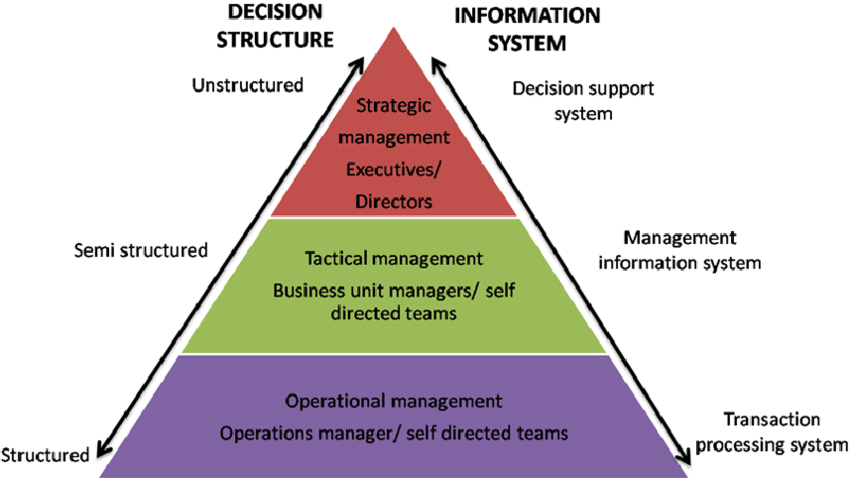A management information system (MIS) is an information system used for decision-making, and for the coordination, control, analysis, and visualization of information in an organization.
The study of the management information systems testing people, processes and technology in an organizational context.
MIS is the use of information technology, people, and business processes to record, store and process data to produce information that decision makers can use to make day to day decisions. The full form of MIS is Management Information Systems. The purpose of MIS is to extract data from varied sources and derive insights that drive business growth.
The following are some of the justifications for having an MIS system
Decision makers need information to make effective decisions. Management Information Systems (MIS) make this possible.
MIS systems facilitate communication within and outside the organization employees within the organization are able to easily access the required information for the day to day operations. Facilitates such as Short Message Service (SMS) & Email make it possible to communicate with customers and suppliers from within the MIS system that an organization is using.
Record keeping: Management information systems record all business transactions of an organization and provide a reference point for the transactions.
Components of MIS
The major components of a typical MIS long-form (Management Information System) are:
- People: People who use the information system
- Data: The data that the information system records
- Business Procedures: Procedures put in place on how to record, store and analyze data
- Hardware: These include servers, workstations, networking equipment, printers, etc.
- Software: These are programs used to handle the data. These include programs such as spreadsheet programs, database software, etc.
Types of Information Systems
The type of information system that a user uses depends on their level in an organization. The following diagram shows the three major levels of users in an organization and the type of information system that they use.

- Transaction Processing Systems (TPS)
This type of information system is used to record the day to day transactions of a business. An example of a Transaction Processing System is a Point of Sale (POS) system. A POS system is used to record the daily sales.
- Management Information Systems (MIS)
Management Information Systems abbreviated as MIS, are used to guide tactic managers to make semi-structured decisions. The output from the transaction processing system is used as input to the MIS system.
- Decision Support Systems (DSS)
Decision support systems are used by top level managers to make semi-structured decisions. The output from the Management Information System is used as input to the decision support system. DSS systems also get data input from external sources such as current market forces, competition, etc.
Role of Management Information System
Management information system (MIS) has become Very Necessary due to Emergence of high complexity in Business Organization. It is all to know that without information no Organization can take even one step properly regarding the decision making process. Because it is matter of fact that in an organization decision plays an essential role for the achievement of its objectives and we know that every decision is based upon information. If gathered information are irrelevant than decision will also incorrect and Organization may face big loss & lots of Difficulties in Surviving as well.
- Helps in Decision making
Management Information System (MIS) plays a significant Role in Decision making Process of any Organization. Because in Any organization decision is made on the basis of relevant Information and relevant information can only be Retrieving from the MIS.
- Helps in Coordination among the Department
Management information System is also help in establishing a sound Relationship among the every persons of department to department through proper exchanging of Information’s.
- Helps in Finding out Problems
As we know that MIS provides relevant information about the every aspect of activities. Hence, If any mistake is made by the management then Management Information Systems (MIS) Information helps in Finding out the Solution of that Problem.
- Helps in Comparison of Business Performance
MIS store all Past Data and information in its Database. That why management information system is very useful to compare Business organization Performance. With the help of Management information system (MIS) Organization can analyze his Performance means whatever they do last year or Previous Years and whatever business performance in this year and also measures organization Development and Growth.
Components of MIS and their relationship
A management information system is made up of five major components namely people, business processes, data, hardware, and software. All of these components must work together to achieve business objects.
- People
These are the users who use the information system to record the day to day business transactions. The users are usually qualified professionals such as accountants, human resource managers, etc. The ICT department usually has the support staff who ensure that the system is running properly.
- Business Procedures
These are agreed upon best practices that guide the users and all other components on how to work efficiently. Business procedures are developed by the people i.e. users, consultants, etc.
- Data
The recorded day to day business transactions. For a bank, data is collected from activities such as deposits, withdrawals, etc.
- Hardware
Hardware is made up of the computers, printers, networking devices, etc. The hardware provides the computing power for processing data. It also provides networking and printing capabilities. The hardware speeds up the processing of data into information.
- Software
These are programs that run on the hardware. The software is broken down into two major categories namely system software and applications software. System software refers to the operating system i.e. Windows, Mac OS, and Ubuntu, etc. Applications software refers to specialized software for accomplishing business tasks such as a Payroll program, banking system, point of sale system, etc.